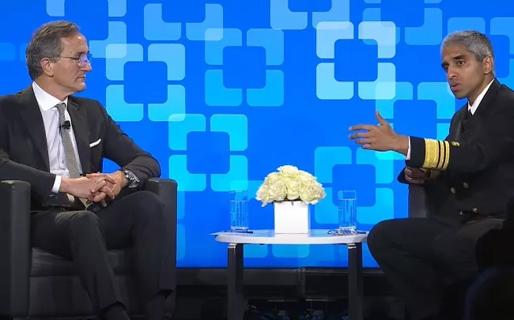Patient navigator is the bridge across systems

As a child and adolescent psychiatrist, Molly Wimbiscus, MD, has had an interest in education since before medical school. She was even part of a group of families that started a charter school in Cleveland years ago. That venture required heavy involvement in the governance and operations of the school, which only deepened Dr. Wimbiscus’ enthusiasm for the educational realm.
Advertisement
Cleveland Clinic is a non-profit academic medical center. Advertising on our site helps support our mission. We do not endorse non-Cleveland Clinic products or services. Policy
In her role as Program Director of the Children and Adolescent Psychiatry Fellowship Program at Cleveland Clinic, Dr. Wimbiscus trains doctors, often from other countries, who may have had different educational experiences and backgrounds. “The experience of understanding United States schools and their heterogeneity, whether they’re public, private, charter or residential, is pretty important,” she says.
This need for training child and adolescent psychiatry fellows in the educational space, a requirement of their fellowship, prompted the development of the Cleveland Clinic Children’s School Mental Health Program. “We started doing it to train the doctors to understand the complexities of schools and how we can better interface with them to support youth with mental health challenges,” says Dr. Wimbiscus.
The program began with fellows rotating through schools, observing classrooms and working with staff to identify ways to support kids with mental health issues. The goal was for each fellow to develop a capstone project that served the school’s needs, and to enable fellows to become better partners.
Now, the School Mental Health Program has expanded beyond simply training into several additional areas, including a clinical service line, research data tracking and community service. Dr. Wimbiscus says the program is designed to reduce strain on families, the cost of hospitalization or emergency room visits and unnecessary breaks in the process, as well as to improve care coordination from healthcare to school.
Advertisement
One component of the program is the Virtual Access Clinic, which allows a psychiatrist or physician assistant to do a virtual psychiatric evaluation before a child is in crisis. There’s also the Transition Bridge Program, which supports students returning to school after hospitalization. “This enables schools to feel more comfortable and enact strategies to support students’ post-hospitalization, which is particularly important because this is when they’re at the highest risk for rehospitalization or mental health decline,” says Dr. Wimbiscus.
In 2018, the program began a collaborative care clinic in one district in Cleveland to work with primary care and mental health care in the school system to best support youth. “It turned out that close to 70% of the kids being seen in the clinic were for mental health reasons, so we knew that we needed to be able to provide services for them,” Dr. Wimbiscus says.
The program received a SAMHSA grant in 2022 to fund a specific position called the mental health (MH) navigator. This person is a mental health professional who is fully employed by Cleveland Clinic, but also receives funds from the specific school district they’re in to pay for their role, which involves working with and supporting school staff, clinical teams, students and their families.
“You can try to mechanize or automate systems, but when it comes to kids, it’s relational, and those corners can’t be cut,” says Dr. Wimbiscus. “Our program is unique in having a highly committed, talented human being in a position that straddles the two spaces of education and healthcare and helps create the flow and the communication between them.”
Advertisement
The MH navigator receives referrals from the school, primary care partners and family members through a secure database called REDCap. When a referral comes in, the patient navigator contacts the student’s family to do triage and decide on the next best step. “Oftentimes, it’s not healthcare,” says Dr. Wimbiscus. She says more than 50% are referred to outside partners in the community.
The MH navigator can help the guidance counselor do the safety assessment or do a crisis evaluation themselves. The student is then referred to the in-school clinic or another resource, where a care plan is formed.
“Many times, the student just needs to get connected quickly and have a therapist on board or maybe work with the teachers on some breaks with work reduction and some time for recovery,” says Dr. Wimbiscus. “Or they might need to have a medical assessment or address an eating disorder. There are so many other things that can be going on.”
Additionally, the MH navigator provides multigenerational care, conducting sessions with parents on strategies to support their children with issues such as anxiety, depression, disruptive behavior, trauma, autism and school problems.
Currently, the program has two MH navigators, each responsible for a specific school district. “Through our SAMHSA grant, we’re expanding our original program to three additional districts, so our hope is to hire two more MH navigators,” explains Dr. Wimbiscus.
Another aspect of the school mental health program is to provide expertise, training and support for mental health interventions under development in the schools. “If there’s a concern or a question, they have somebody to call, which builds their confidence and helps them feel more comfortable knowing that they have additional resources to fall upon,” says Dr. Wimbiscus.
Advertisement
Weekly 30-minute care coordination meetings with school staff and the clinical team are a significant piece of the program. “It may not sound like a lot, but it’s huge when you get to sit down with a team of guidance counselors and principals and discuss complex cases in which you need to have different people providing input to better support the child,” Dr. Wimbiscus says.
The MH navigator ensures the correct releases of information are signed so that services can be provided collaboratively to best support students while following HIPAA and FERPA (Family Educational Rights and Privacy Act). This is vital to the success of the weekly care coordination meetings “where we talk about our patients in a HIPAA/FERPA-compliant way, because the value for clinical outcomes has been notable,” says Dr. Wimbiscus.
The program’s outcomes have been significant. “We had a whole list of kids this past school year we were so worried about, who had struggled tremendously with depression, self-harm and substance abuse and were barely getting by,” says Dr. Wimbiscus. “The best weekly consultation meeting was in the middle of May when the guidance counselors said most of them were going to graduate — it’s just such an exciting time.”
In fact, Dr. Wimbiscus says the majority of the kids the program has worked with have graduated and gone on to a career or college. “They, along with their parents, are grateful for this team of adults across the spectrum; these wonderful guidance counselors, therapists and clinical providers who have supported them,” she says.
Advertisement
Dr. Wimbiscus says her team would love to talk to any organization who is interested in implementing a similar program. She believes the MH navigator role is well worth the cost, thanks to its function as a bridge between the domains of healthcare and education. “There’s a synergistic, exponential positive outcome to this program, knowing that you’re part of a bigger team and working collaboratively to support kids and families, as well as each other,” she says.
Advertisement

A closer look at current uses and future opportunities

The Nation’s Doctor visits Cleveland Clinic to call attention to urgent public health issues

Promoting accessibility for all children

5 things a child psychiatrist wishes all pediatricians would do

Peer-to-peer videos offer creative solution to help patients while they wait

Key findings and what it could mean for identifying high-risk patients

Integrated care model reduces length of stay, improves outpatient pain management

A closer look at the impact on procedures and patient outcomes